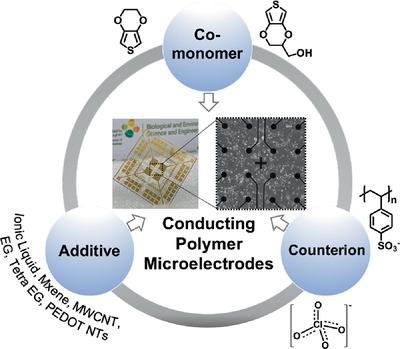当前位置:
X-MOL 学术
›
Macromol. Biosci.
›
论文详情
Our official English website, www.x-mol.net, welcomes your
feedback! (Note: you will need to create a separate account there.)
Benchmarking the Performance of Electropolymerized Poly(3,4-ethylenedioxythiophene) Electrodes for Neural Interfacing.
Macromolecular Bioscience ( IF 4.4 ) Pub Date : 2020-08-20 , DOI: 10.1002/mabi.202000215 Georgios Nikiforidis 1 , Shofarul Wustoni 1 , Cyril Routier 1 , Adel Hama 1 , Anil Koklu 1 , Abdulelah Saleh 1 , Nadia Steiner 2 , Victor Druet 1 , Hubert Fiumelli 2 , Sahika Inal 1
Macromolecular Bioscience ( IF 4.4 ) Pub Date : 2020-08-20 , DOI: 10.1002/mabi.202000215 Georgios Nikiforidis 1 , Shofarul Wustoni 1 , Cyril Routier 1 , Adel Hama 1 , Anil Koklu 1 , Abdulelah Saleh 1 , Nadia Steiner 2 , Victor Druet 1 , Hubert Fiumelli 2 , Sahika Inal 1
Affiliation

|
The development of electronics adept at interfacing with the nervous system is an ever‐growing effort, leading to discoveries in fundamental neuroscience applied in clinical setting. Highly capacitive and electrochemically stable electronic materials are paramount for these advances. A systematic study is presented where copolymers based on 3,4‐ethylenedioxythiophene (EDOT) and its hydroxyl‐terminated counterpart (EDOTOH) are electropolymerized in an aqueous solution in the presence of various counter anions and additives. Amongst the conducting materials developed, the copolymer p(EDOT‐ran‐EDOTOH) doped with perchlorate in the presence of ethylene glycol shows high specific capacitance (105 F g−1), and capacitance retention (85%) over 1000 galvanostatic charge–discharge cycles. A microelectrode array‐based on this material is fabricated and primary cortical neurons are cultured therein for several days. The microelectrodes electrically stimulate targeted neuronal networks and record their activity with high signal‐to‐noise ratio. The stability of charge injection capacity of the material is validated via long‐term pulsing experiments. While providing insights on the effect of additives and dopants on the electrochemical performance and operational stability of electropolymerized conducting polymers, this study highlights the importance of high capacitance accompanied with stability to achieve high performance electrodes for biological interfacing.
中文翻译:

对用于神经接口的电聚合聚(3,4-亚乙基二氧噻吩)电极的性能进行基准测试。
擅长与神经系统接口的电子设备的开发是一项不断增长的努力,导致在临床环境中应用基础神经科学的发现。高电容和电化学稳定的电子材料对于这些进步至关重要。提出了一项系统研究,其中基于 3,4-亚乙基二氧噻吩 (EDOT) 及其端羟基对应物 (EDOTOH) 的共聚物在各种抗衡阴离子和添加剂存在的水溶液中进行电聚合。在开发的导电材料中,在乙二醇存在下掺杂高氯酸盐的共聚物 p(EDOT- ran- EDOTOH) 显示出高比电容 (105 F g -1),以及超过 1000 次恒电流充放电循环后的电容保持率 (85%)。制造了基于这种材料的微电极阵列,并将原代皮层神经元在其中培养数天。微电极电刺激目标神经元网络并以高信噪比记录其活动。通过长期脉冲实验验证了材料电荷注入能力的稳定性。在深入了解添加剂和掺杂剂对电聚合导电聚合物的电化学性能和操作稳定性的影响的同时,该研究强调了高电容和稳定性的重要性,以实现用于生物界面的高性能电极。
更新日期:2020-08-20
中文翻译:

对用于神经接口的电聚合聚(3,4-亚乙基二氧噻吩)电极的性能进行基准测试。
擅长与神经系统接口的电子设备的开发是一项不断增长的努力,导致在临床环境中应用基础神经科学的发现。高电容和电化学稳定的电子材料对于这些进步至关重要。提出了一项系统研究,其中基于 3,4-亚乙基二氧噻吩 (EDOT) 及其端羟基对应物 (EDOTOH) 的共聚物在各种抗衡阴离子和添加剂存在的水溶液中进行电聚合。在开发的导电材料中,在乙二醇存在下掺杂高氯酸盐的共聚物 p(EDOT- ran- EDOTOH) 显示出高比电容 (105 F g -1),以及超过 1000 次恒电流充放电循环后的电容保持率 (85%)。制造了基于这种材料的微电极阵列,并将原代皮层神经元在其中培养数天。微电极电刺激目标神经元网络并以高信噪比记录其活动。通过长期脉冲实验验证了材料电荷注入能力的稳定性。在深入了解添加剂和掺杂剂对电聚合导电聚合物的电化学性能和操作稳定性的影响的同时,该研究强调了高电容和稳定性的重要性,以实现用于生物界面的高性能电极。











































 京公网安备 11010802027423号
京公网安备 11010802027423号